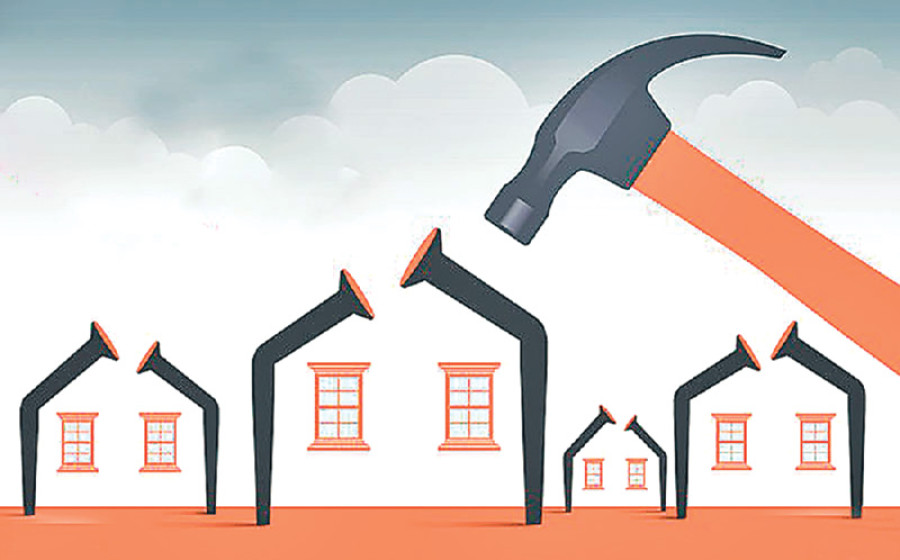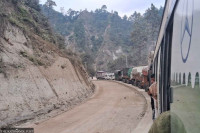Opinion
Understanding resilience
Simply incorporating the term in the local lexicon without unpacking its tenets could render the concept meaningless
Ajaya Dixit, Ashutosh Shukla & Kanmani Venkateswaran
Over a year after the 2015 Gorkha Earthquake, the process of recovery is slow moving. Hundreds of entities and thousands of households are working towards recovery, and yet what it means to recover as a society is undefined. As winters and monsoons have passed, and as landslides, flood and drought hazards continue to increase, the path to recovery has become even more daunting.
In the midst of this, the ongoing public discourse on how to recover from the earthquake and its subsequent aftershocks has emphasised the need to ‘build back better’ and to build ‘resilience’. In order to integrate resilience into recovery, it is important to understand what resilience actually means and how both concepts are different but complementary to each other.
Build back better implies that the rebuilt physical infrastructures damaged by the earthquakes should be of higher quality, safer, aesthetically more pleasing and better managed than their pre-damaged forms. It also implies that the rebuilt infrastructure should be able to withstand the impacts if and when a new hazard hits. However, what ‘resilience’ implies is not very clear.
Originating from the Latin word resiliens, the idea of resilience is used in many different ways. For natural ecosystems, resilience is the ability of an ecosystem to absorb disturbances and change, while maintaining the same structural functions and providing the same basic services. This idea needs to be modified when talking about social systems, which, unlike natural systems, are not hardwired to react in a particular way. Humans have the freedom to make choices and these choices can differ across political and social spectrums. Thus responses to stresses also differ.
To practically build resilience requires us to ask, “why build resilience and to what?” Is resilience solely concerned with the capacity to deal with increasing climatic hazards? Is it surviving sudden-onset events like earthquakes, or is it the ability to cope with chronic issues like the lack of reliable energy, clean drinking water, nutrition, health and employment? Should resilience focus on infrastructure, on businesses, on government, or on people? And at what level should resilience building be accomplished—individual, household, community or national?
These questions require deeper scrutiny in order to understand how to build back better and introduce resilience in this post-earthquake situation. We need to move away from common misconceptions that robustness of physical infrastructures and resilience are one and the same. Rather, we need to ensure that rebuilt infrastructures do not fail instantaneously, and in the process avoid the social and governance gaps that have previously exacerbated vulnerabilities and led to deaths, losses,
and damages. The answers can help identify lapses in policy and action and contribute to more effective recovery and risk reduction efforts. They can enable the government agencies, local communities, households, funders and society at large to better target their resources.
Things to consider
All human-built and natural systems are exposed to shocks. A landslide could lead to the collapse of a forest patch in a hilly slope while simultaneously damaging the livelihoods of those dependent on the damaged forest patch, houses, bridges or roads. However, while the forest may be able to regenerate itself, the damaged houses, bridges and roads cannot revert back to their original state on their own.
The capacity of human-built structures to withstand shocks largely depends on a diverse range of factors such as design considerations, quality of materials, utilisation and maintenance. Thus, no human-built system can be made completely secure or fail-proof to all types and magnitudes of hazards. Building physical infrastructure to withstand hazards of large magnitudes is costly. And even if built in such a way, there is no guarantee that the built system will not fail.
Moreover, reconstruction of a damaged infrastructure is not simply about assembling the materials to produce a functional built form; it is also about ensuring that the system can provide the services it has been designed to produce. If such a system must fail, then it should fail safely.
This means the failure should not cause systemic disruption leading to losses of lives or livelihoods, and should continue to provide critical services despite the damage.
A school building, for example, must be safe, create a healthy learning environment, promote social inclusion and provide a platform for interfacing with the community while fostering continuous academic progress, no matter the circumstance. Continuity of services can be maintained by incorporating multiple units in the design of a physical system. An understanding of the social processes and institutional context is equally important.
Elements of resilience
Resilience building is a continuous process. Such efforts must be directed towards the human-built systems that people depend on, such as drinking water, electricity, telecommunications, and transportation. These systems provide services that are critical at all times, in non-disaster and disaster situations. It must be noted that building resilience in human-built systems should not be at the cost of natural ecosystems, particularly water and forest, which the majority of Nepali people depend on for their livelihoods.
Building resilience requires simultaneous focus on improving knowledge about exposure, improving the quality of systems, building the capacity of individuals and households, and implementing appropriate policy measures. The lack of one of these attributes can escalate loss and damages when a hazard hits.
Prior to the Gorkha Earthquake, social amnesia and apathy had prevailed, despite repeated warnings from experts about an imminent earthquake. Though knowledge about hazard exposure is recognised to be crucial, especially for incorporating resilience into development, investment in knowledge generation is inadequate in Nepal.
The quality of homes, particularly in rural areas, was another factor leading to high losses. Most earthquake-damaged rural homes were built with random rubble masonry in mud mortar. Even in cement concrete homes the sizing and detailing of components, the selection of materials, and construction practices were poor. Low-income and marginalised families have largely been excluded from efforts to disseminate knowledge on safe construction. The value of safer homes has not been an agenda of the country’s development journey.
The regulatory mechanism for infrastructure development in the country, overall, is inadequate, fragmented and ineffective. Disaster management has been limited to emergency response and relief and has over time faded into a post disaster status quo, rather than into disaster risk reduction.
Avoiding future ruptures
The Gorkha Earthquake has created ruptures across Nepal’s sectors and administrative and political realms, from the local to national levels. These ruptures have revealed opportunities to identify and reduce the vulnerabilities that have led to high losses. Transitioning to a resilient future requires overcoming deficiencies in policies and practices, capacitating individuals, communities and government agencies, promoting learning, generating relevant knowledge and applying it.
Resilience building involves a new way of pursuing development and recovery from disasters. It is about bringing to bear the inner strength of humans so that they are able to successfully deal with various kinds of shocks and minimise associated risks. Simply incorporating the term resilience in the local lexicon without unpacking its tenets could render the concept meaningless and may even promote its misuse. Both will only serve to hinder recovery processes in the long run.
Dixit and Shukla are with ISET-Nepal; Venkateswaran is with the US-based ISET-International




 17.67°C Kathmandu
17.67°C Kathmandu












